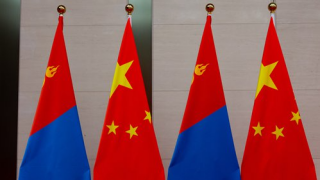By Hua Dan, Liu Zheng and Xiao Liming
Hoa đan Lưu tranh tiếu lực minh
Japan plans to issue construction bonds worth 511.7 billion yen ($3.29 billion) to finance its defense buildup this year, an increase of 77.4 billion yen from the previous year, according to Japanese media reports on May 7. It is reported that in 2023, the Kishida government abandoned Japan's previous policy of not relying on borrowing to cover defense expenses, in an attempt to strengthen the so-called defense capability.
Theo Nhật Bản truyền thông 5 nguyệt 7 nhật báo nói, Nhật Bản kế hoạch năm nay phát hành 5117 trăm triệu ngày nguyên xây dựng quốc trái, dùng để gom góp phòng vệ phí tổn. Này một kim ngạch so năm trước gia tăng 774 trăm triệu ngày nguyên. Được biết, 2023 năm, ngạn điền chính phủ vì cường hóa cái gọi là phòng vệ lực, giải trừ Nhật Bản trước đây kiên trì không dựa mượn tiền gom góp phòng vệ phí tổn phương châm.
In recent years, Japan has accelerated the transformation of its defense system, increased its defense spending year by year and continuously promoted the militarization of civilian resources. From the use of public debt for military purposes, to the large-scale upgrading and expansion of civil airports and seaports that began last year, to the recent admission of US warships to its civil ports, all these moves demonstrate that Japan is constantly breaking the framework of the pacifist constitution, deliberately blurring the boundaries between peacetime and wartime, and accelerating the expansion of its military power. These acts show a dangerous and belligerent tendency.
Năm gần đây, Nhật Bản gia tốc thúc đẩy phòng vệ thể chế chuyển hình, từng năm gia tăng phòng vệ phí tổn, không ngừng thúc đẩy dân dụng tài nguyên quân sự hóa. Từ đem công cộng nợ nần dùng cho quân sự mục đích, đến năm trước bắt đầu đối dân dụng sân bay cùng cảng tiến hành đại quy mô thăng cấp xây dựng thêm, lại đến không lâu trước đây tiếp nhận quân Mỹ tàu chiến ngừng dân dụng cảng, đủ loại động tác cho thấy, Nhật Bản chính không ngừng đánh vỡ hoà bình hiến pháp dàn giáo, cố tình mơ hồ bình chiến giới hạn, gia tốc khuếch trương lực lượng quân sự, bày biện ra nguy hiểm hiếu chiến hướng đi.
After the end of World War II, to prevent the further expansion of Japan's militarist power, the US not only took measures to destroy the defense industrial base that supported Japan's capacity to launch wars, but also strictly limited its military spending and the size of its Self-Defense Forces. Bound by the pacifist constitution, Japan is highly reliant on protection from the US in terms of military security, and devotes its main energy to the development of the civil economy.
Thế chiến 2 sau khi kết thúc, nước Mỹ vì phòng ngừa Nhật Bản chủ nghĩa quân phiệt lực lượng lại lần nữa khuếch trương, không chỉ có áp dụng thi thố phá hủy chống đỡ Nhật Bản phát động chiến tranh quốc phòng công nghiệp cơ sở, còn nghiêm khắc hạn chế này quân phí phí tổn cùng tự vệ đội quy mô. Chịu hoà bình hiến pháp ước thúc, Nhật Bản ở an toàn thượng độ cao ỷ lại nước Mỹ che chở, đem chủ yếu tinh lực dùng ở phát triển dân dụng kinh tế thượng.
However, this does not mean that the Japanese right-wing forces have given up their ambition to rebuild Japan into a military power. In recent years, as the US speeds up its pursuit of "great power competition" and the "Indo-Pacific strategy", Japan has seized the opportunity to constantly strengthen its military ties with the US, in an attempt to loosen restrictions on its military development. During the Abe administration, Japan removed the ban on the right of collective self-defense under the slogan of "Proactive Pacifism", which severely weakened the restrictions on the scope of activities of the Japan Self-Defense Forces imposed by the pacifist constitution.
Nhưng mà, này cũng không ý nghĩa Nhật Bản hữu quân từ bỏ mưu cầu trở về quân sự đại quốc dã tâm. Năm gần đây, theo nước Mỹ gia tốc đẩy mạnh “Đại quốc cạnh tranh” cùng “Ấn quá chiến lược”, Nhật Bản nhân cơ hội không ngừng tăng mạnh cùng nước Mỹ quân sự buộc chặt, ý đồ lấy này đổi lấy tự thân quân sự mở trói. An lần chấp chính thời kỳ bắt đầu đánh “Tích cực hoà bình chủ nghĩa” cờ hiệu, mạnh mẽ bỏ lệnh cấm tập thể tự vệ quyền, lệnh hoà bình hiến pháp đối tự vệ đội gây hoạt động phạm vi hạn chế đã chịu nghiêm trọng suy yếu.
The Kishida government has mostly inherited Abe's legacy in Japanese security policy. It not only revised the three security and defense-related documents to add provisions allowing Japan to build counterattack capabilities, but also unabashedly shifted Japan's defense system to a defense architecture of the whole country. At the end of 2022, Japan adopted a new version of National Defense Strategy, which defines the defense architecture of the whole country as building "an overall national defense architecture by integrating Japan's national power--diplomatic, intelligence, economic, and technological--as well as by systematically combining all policy means." In July 2023, Japan released its new Defense of Japan white paper, which further elaborates on the defense architecture of the whole country, emphasizing that in the future, it would adopt an integrated system to improve the effectiveness of joint operations and achieve seamless operation across all phases from peacetime to armed contingencies.
Ngạn điền chính phủ rất lớn trình độ thượng kế thừa an lần an bảo di sản, không chỉ có sửa chữa tam phân an bảo chính sách văn kiện, gia tăng rồi cấu trúc “Phản kích năng lực” tiến công tính điều khoản, còn đem phòng vệ thể chế không chút nào che giấu mà chuyển hướng “Cử quốc phòng vệ”. 2022 cuối năm, Nhật Bản thông qua tân bản 《 quốc gia phòng vệ chiến lược 》, đem “Cử quốc phòng vệ thể chế” định nghĩa vì “Tổng hợp Nhật Bản sở có được ngoại giao năng lực, kinh tế năng lực chờ các hạng năng lực, hệ thống hóa tổ hợp vận dụng các loại chính sách thủ đoạn chế tạo” phòng vệ thể chế. 2023 năm 7 nguyệt, Nhật Bản chính thức tuyên bố tân bản 《 phòng vệ sách bìa trắng 》 đối nên thể chế làm ra tiến thêm một bước trình bày, cường điệu tương lai đem áp dụng nhất thể hóa liên hợp vận dụng thể chế, tăng lên liên hợp tác chiến hiệu năng, thực hiện từ ngày thường đến thời gian chiến tranh vô phùng hàm tiếp.
In fact, the above-mentioned concept complies with the so-called "whole-of-government and whole-of-society" approaches of the US, seeking to concentrate resources from all sectors, and coordinate the efforts of governments at all levels, non-governmental organizations, and even individuals, blur the boundaries between peacetime and wartime, and ultimately enhance Japan's overall military deterrence. These moves with hidden evil intentions fully manifest the dangerous changes in Japan's defense system.
Kể trên khái niệm trên thực tế là tuần hoàn nước Mỹ cái gọi là “Toàn chính phủ, toàn xã hội” đường nhỏ, mưu cầu tập trung các phương diện tài nguyên, trù tính chung các cấp chính phủ, dân gian cơ cấu thậm chí cá nhân lực lượng, mơ hồ bình chiến giới hạn, cuối cùng tăng cường chỉnh thể quân sự uy hiếp lực. Này đó giấu giếm dã tâm hành động, đầy đủ đột hiện Nhật Bản phòng vệ thể chế nguy hiểm chuyển biến.
In recent years, while significantly adjusting its security strategy, Japan has also advanced and expanded military-civilian resource sharing in preparation for its involvement in future wars. To this end, Japan spares no effort to hype up the "military threats" it will probably face in the future and deliberately describes the increasingly complicated geopolitical environment as a "security threat" facing the Japanese people. To "fully defend the lives and livelihoods of Japanese nationals", Japan's Ministry of Defense has demanded that the defense budget be doubled from 1% of GDP in 2023 to 2% by 2027. To raise funds to cover the massive defense expenses, the Japanese government is bound to issue bonds on a large scale, which will further aggravate its fiscal difficulties.
Ở chiều sâu điều chỉnh an bảo chiến lược đồng thời, năm gần đây, Nhật Bản còn gia tốc mở rộng quân dân xài chung tài nguyên, ý đồ vì tham gia tương lai chiến tranh làm chuẩn bị. Nhật Bản cực lực nhuộm đẫm tương lai khả năng lọt vào quân sự uy hiếp, cũng đem ngày càng phức tạp mà duyên hoàn cảnh biến hóa nói thành là đối nước Nhật dân “An toàn uy hiếp”, vì “Hữu hiệu bảo vệ quốc dân”, Nhật Bản phòng vệ tỉnh đã yêu cầu 2027 năm trước, đem phòng vệ dự toán chiếm quốc nội sinh sản tổng giá trị tỉ trọng từ 2023 năm 1% tăng gấp bội đến 2%. Vì kiếm khổng lồ phòng vệ dự toán, Nhật Bản chính phủ thế tất đại lượng phát hành phiếu công trái, này cũng đem dẫn tới Nhật Bản tài chính khốn cảnh tiến thêm một bước tăng thêm.
On May 3, more than 30,000 Japanese citizens flooded the streets of Tokyo in a massive rally to defend their country's pacifist constitution and express their strong anxiety about the rising militarist tendency in Japan. After Japan introduced the defense architecture of the whole country, people could not help but recall the dark history of the Japanese military during World War II when it carried out the "total war". At that time, the Japanese rulers completely placed the country under the control of the militarists, with its political, economic, ideological, and educational sectors all involved in its war of aggression. All Japanese people became a component of the "war machine"; they either participated in the war in person or provided support in the rear areas, forming the social basis for Japan to launch the war of aggression.
5 nguyệt 3 ngày, 3 vạn dư danh Nhật Bản dân chúng ở Đông Kinh cử hành hộ hiến tập hội biểu đạt đối Nhật Bản tân chủ nghĩa quân phiệt hướng đi mãnh liệt bất an. “Cử quốc phòng vệ thể chế” đưa ra sau, làm người không cấm liên tưởng khởi Thế chiến 2 trong lúc Nhật Bản quân bộ thi hành “Tổng lực chiến” hắc ám lịch sử. Lúc ấy, Nhật Bản người đương quyền đem quốc gia hoàn toàn đặt chủ nghĩa quân phiệt phần tử khống chế dưới, này quốc nội chính trị, kinh tế, tư tưởng, giáo dục chờ lĩnh vực toàn bộ bị nạp vào xâm lược chiến tranh quỹ đạo. Toàn thể quốc dân bị trói thượng cỗ máy chiến tranh, hoặc tham chiến, hoặc tiến hành phía sau chi viện, cấu thành Nhật Bản phát động xâm lược chiến tranh xã hội cơ sở.
At present, more and more Japanese people are expressing strong dissatisfaction with the expansion of military strength by those in power under the guise of civilian use, and they worry that they will be forcibly tied to the chariot of militarism and become "cannon fodder" in war again. The international community also worries that Japan is repeating the old path of militarism by devoting more civilian resources to supporting arms expansion.
Trước mặt, càng ngày càng nhiều Nhật Bản dân chúng đối người đương quyền lấy dân dùng vì cờ hiệu phát triển quân lực biểu đạt mãnh liệt bất mãn, lo lắng một lần nữa bị trói thượng chủ nghĩa quân phiệt “Chiến xa”, lại lần nữa trở thành chiến tranh pháo hôi. Quốc tế xã hội cũng lo lắng, Nhật Bản đem dân dụng tài nguyên càng nhiều mà đầu nhập đến chống đỡ tăng cường quân bị chuẩn bị chiến tranh, là ở đi chủ nghĩa quân phiệt đường xưa.
Currently, the Japanese government is comprehensively promoting the transition of its defense system, which has further deteriorated the regional security situation. This is widely considered an extremely dangerous move. The Japanese government should draw lessons from history, stick to the path of peaceful development, and avoid going further down the dangerous road.
Trước mắt, Nhật Bản chính phủ toàn diện đẩy mạnh phòng vệ thể chế chuyển hình, tiến thêm một bước chuyển biến xấu khu vực an toàn tình thế, đây là cực kỳ nguy hiểm hành động. Nhật Bản chính phủ ứng khắc sâu hấp thu lịch sử giáo huấn, kiên trì đi hoà bình phát triển con đường, tránh cho ở nguy hiểm trên đường càng đi càng xa.
(The authors are from the PLA Army Engineering University.)
( tác giả đơn vị: Lục quân công trình đại học )









